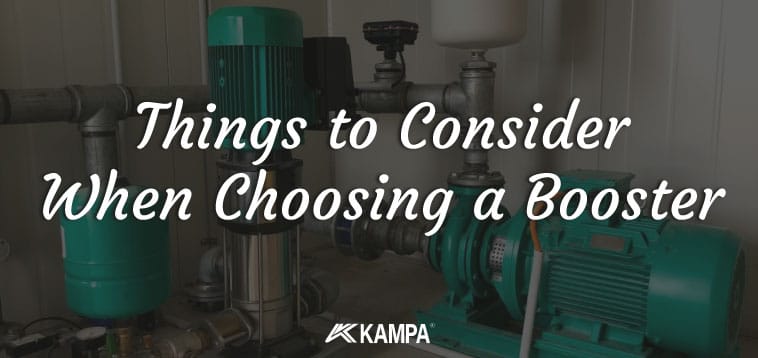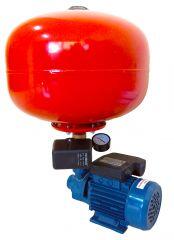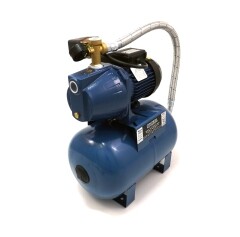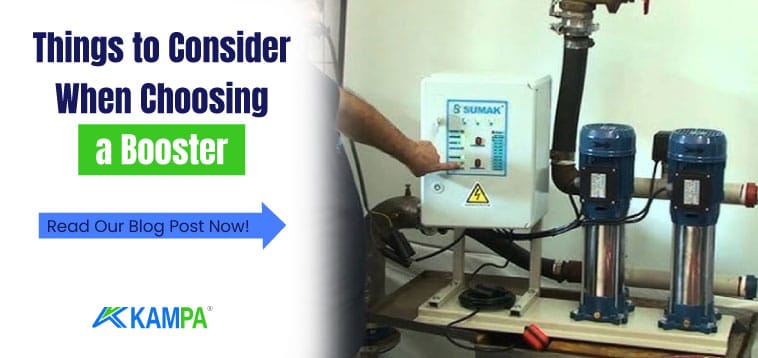Things to Consider When Choosing a Booster
In our previous blog, we briefly touched on the choosing a booster. In this blog, we will talk about the selection of the booster and what we should pay attention to.
The most suitable water booster selection for a certain place of use and operating conditions, the things to be considered in determining the type are as follows. Water booster reinforces the areas of use where water demand or water pressure is insufficient with pressurized water.
If you need the pressure head of the booster to be selected, for example 15 mss, we can say that your water source and booster type are important with the appropriate expansion tank.
If you need 150 liters throughout the day, it is important to learn the capacity of the booster pump suitable for your purpose. Booster pump can be called water pump automatics.
-The first question to be asked for the selection of the booster should be where it will be used, how many people or how manym3will be used in an area.
Then, will the fluid be drawn from the horizontal or vertical surface? In line with your answers to these questions, you will have made the first filtering regarding pressure, flow rate and tank.
-It is correct to meet the total flow requirement with more than one pump in a place with multiple users and where the flow requirement changes over time. For example; in an application where the total flow requirement is 30m3/h, a 3-pump booster with a flow capacity of 10m3/h should be selected instead of a single pump booster.

-When selecting a booster pump, the other pumps should be selected with the capacity to meet the total flow requirement in case one pump fails when a backup function is desired.
-In the selection of pump capacity and number of stages, care should be taken to ensure that the lower and upper pressure operating points are in the appropriate region of the efficiency curve.
In determining the pump type, the suitability of the NPSH characteristic should be confirmed according to the installation conditions in which the hydrophore will operate. If suction will be required in its selection, this situation is indicated and relevant structural measures are taken.-
Pressure Selection Chart for Choosing a Booster
| Number of Floors | Pump Max. Operating Pressure bar |
| 1 | 3,5 |
| 2 | 3,9 |
| 3 | 4,2 |
| 4 | 4,6 |
| 5 | 4,9 |
| 6 | 5,2 |
| 7 | 5,6 |
| 8 | 5,9 |
| 9 | 6,3 |
| 10 | 6,6 |
| 11 | 7,0 |
| 12 | 7,3 |
| 13 | 7,7 |
| 14 | 8,0 |
| 15 | 8,4 |
| 16 | 8,7 |
| 17 | 9,0 |
| 18 | 9,4 |
| 19 | 9,7 |
| 20 | 10,1 |
| 21 | 10,4 |
| 22 | 10,8 |
| 23 | 11,1 |
| 24 | 11,5 |
| 25 | 11,8 |
| 26 | 12,6 |
| 27 | 12,5 |
| 28 | 12,8 |
| 29 | 13,2 |
| 30 | 13,5 |
Flow Rate Selection Chart for Booster Selection
| Number of Flats | Pump Min. Operation Flow Rate (m3/h) | Number of Flats | Pump Min. Operation Flow Rate (m3/h) |
| 1 | 0,4 | 31 | 6,5 |
| 2 | 0,8 | 32 | 6,7 |
| 3 | 1,2 | 36 | 6,9 |
| 4 | 1,6 | 34 | 7,2 |
| 5 | 1,2 | 35 | 7,4 |
| 6 | 1,5 | 36 | 7,6 |
| 7 | 1,7 | 37 | 7,8 |
| 8 | 2 | 38 | 8 |
| 9 | 2,2 | 39 | 8,2 |
| 10 | 2,4 | 40 | 8,4 |
| 11 | 2,3 | 41 | 8,6 |
| 12 | 2,5 | 42 | 8,8 |
| 13 | 2,7 | 43 | 9 |
| 14 | 2,9 | 44 | 9,3 |
| 15 | 3,2 | 45 | 9,5 |
| 16 | 3,4 | 46 | 9,7 |
| 17 | 3,6 | 47 | 9,9 |
| 18 | 3,8 | 48 | 10,1 |
| 19 | 4 | 49 | 10,3 |
| 20 | 4,2 | 50 | 10,5 |
| 21 | 4,4 | 51 | 10,7 |
| 22 | 4,6 | 52 | 10,9 |
| 23 | 4,8 | 53 | 11,1 |
| 24 | 5 | 54 | 11,3 |
| 25 | 5,3 | 55 | 11,6 |
| 26 | 5,5 | 56 | 11,8 |
| 27 | 5,7 | 57 | 12 |
| 28 | 5,9 | 58 | 12,2 |
| 29 | 6,1 | 59 | 12,4 |
| 30 | 6,3 | 60 | 12,6 |
Flow rate calculation may vary according to user characteristics. For example, a hospital, a hotel or a business center and an apartment building with a different flow rate calculation is an element to be considered in the flow rate calculation in the selection of a booster.
There are main criteria in flow calculation. The first of these is the volume of water that is expected to be consumed per unit time, while the other is the concurrency factor in multi-user systems.
The combination of these two criteria expresses the water flow rate required at a time of peak usage. For booster selection, the flow capacity should be selected to meet this.
The domestic water flow rate calculation should be carried out by taking into account the number of users, the volume of water expected to be consumed per unit time for each user and the simultaneous use factor.
The simultaneous use factor is a factor that assesses the probability of how many users in a multi-user system can consume a predicted amount of water at the same time.
As the number of users, values such as the number of families or individuals living in dwellings, people working at workplaces, the number of beds used in hospitals and hotels are taken into account.
If we explain this with an example;
In a 200-unit public housing settlement
Based on the formula Q (flow rate) = A (number of families) * B (number of individuals) * T (Average Daily Water Consumption of Individuals) * F (simultaneous use)
We can say that Q =200 *4*150*150*0,25=30,000 lt/h, i.e. 30m3/h flow rate is required.
Considering all these details, you can reach different booster selection in line with your needs through our site.
For example
1-For a detached house;

SM5 2 Floor 2 Apartment Hydrophore 24 Liter Tank
2- For 4 apartments on 4 floors

SMJH85 Jet Package Booster 4 Floors 4 Apartments 24 Liters Tank
3- 5 floors for 10 apartments

SMJ 150 5 Floors 10 Flats Booster WNP-10H Hydrometric
Products such as can be used. For more information about booster. Click for detailed information about water booster.

